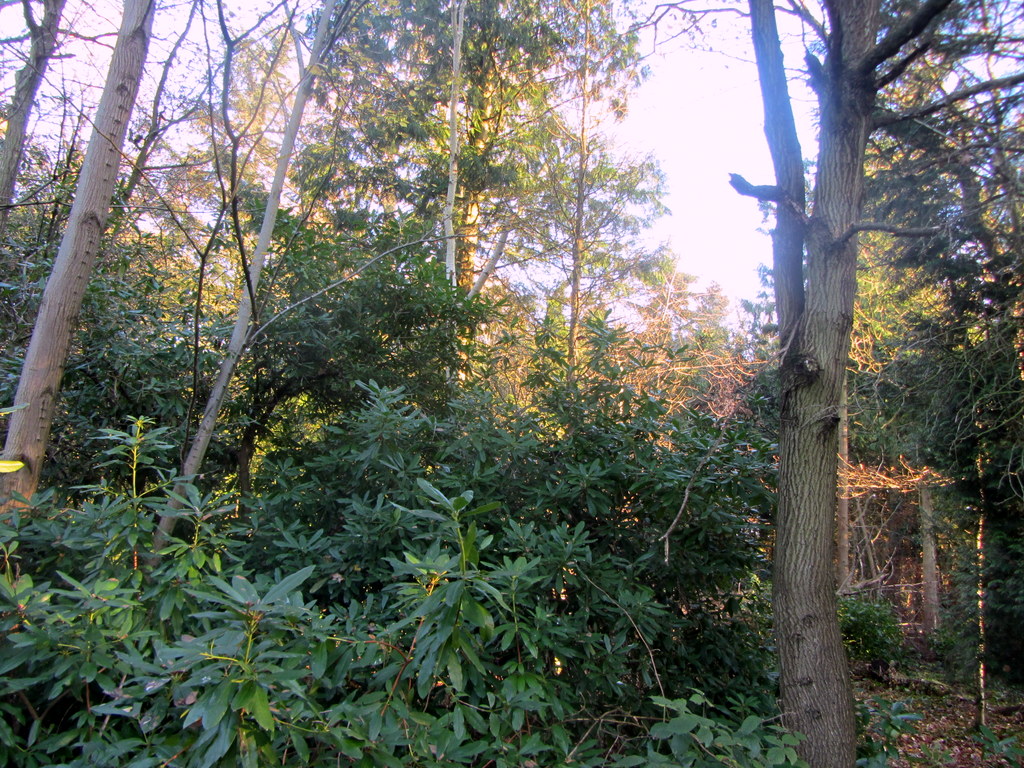Anyone who frequents the part of the Wilderness woodland closest to the Lyle building entrance will have noticed a dramatic change over the last week. A big swathe of invasive rhododendron and laurel has been taken out and chipped, leaving nothing but a blank space and a lingering smell of marzipan* where before there was a thick mass of green growth.
I must admit to having mixed feelings. Dramatic change in a place you know well is always disorienting, even if it is ultimately for a good purpose. Both rhododendron and laurel are absolutely useless for biodiversity – no native insects feed on them and they shade out native woodland wildflowers – but one of my favourite animals, aesthetically speaking, is the glorious green and pink confection that is the rhododendron leafhopper, Graphocephala fennahi, and last September Whiteknights Park became one of just a small handful of sites in the country to record another rhododendron-feeding cicadellid, Placotettix taeniatifrons.
- Rhododendron leafhopper Graphocephala fennahi in Whiteknights Park, October 2014.
- Rhododendron leafhopper Graphocephala fennahi in Windsor Great Park, November 2013.
- Placotettix taeniatifrons, an uncommon introduced leafhopper. Specimen collected in Whiteknights Park, September 2013.
I’ve also noticed fair numbers of invertebrates overwintering in the shelter of the rhododendron and laurel’s thick foliage, which is retained year-round. This small selection of springtails, spiders, parasitic wasps, chironomid midges and flea beetles in turn provides valuable winter food for small insectivorous birds. The first firecrest I ever saw on Whitknights was zipping around a large laurel near the Beech Lane pedestrian gate, and there is often a good sized flock of goldcrests gathering to roost on winter afternoons in the rhododendron on the left-hand side of the main path. Though it’s fair to say that the ‘crests would be at least as happy, if not more so, in holly, ivy and holm oak; their use of introduced plants is undoubtedly opportunistic, rather than an expression of preference.
There is still plenty of rhododendron and laurel left on campus, so you don’t have to go far round the corner from last week’s clearances to find scenes like the one above. And the most important thing to say is that I would expect their removal to ultimately do much more good than harm, providing it has been done thoroughly and the stumps are removed or treated. With any luck we will see a resurgence in native woodland ground flora over the next few springs, or perhaps the establishment of native understory such as bramble, which provides a much better nesting habitat for birds than rhododendron and is the food plant for many native insects. It will be interesting to watch and see what happens.
For those not familiar with the difference between rhododendron and laurel, both have broad, smooth, shiny green leaves, but they’re arranged in very different ways on the stem. On rhododendron they’re in rather beautiful circular whorls (left, below). Laurel’s leaves are more simply arranged in a straight line (right).
*The first commenter to correctly suggest why the delicious marzipan aroma gets…the satisfaction of knowing the answer!








The laurel contains cyanide which smells like marzipan?
It smells like marzipan only if the marzipan has bitter almonds in.
I must be buying dodgy almonds! Or rather I have been known to use them with the skin on, which presumably contains most of the bitter compounds.
Great explanation of what has been going on thanks
The Goldcrest that you mention are they at the Beech lane entrance or on the main path through the wilderness?
Main path – near the entrance that’s by the Lyle tower. But goldcrest are pretty common throughout the Wilderness at the moment, across the whole campus in fact.